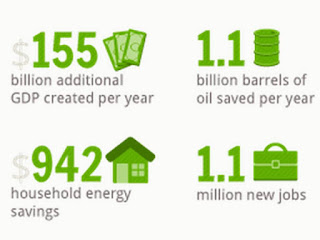- Energy Challenges and Policy actions to strengthen Nation's economical competitiveness
Energy, concerns and strategies are on many peoples minds these days, and rightly so. I recently had the pleasure to see Steven Koonin's, former under Secretary for Science of the DOE, presentation about the use and future of energy from his perspective. In paving the way for future policies, technology developments and societal change, it is quite clear that three major targets for energy shall be met:
From history we can often learn a lot. Taking a look at Nation's changing Energy portfolio over time, we see that it typically takes tens of years for a new energy source to have an meaningful impact (Fig.2). This also means that if we want to changintroiduce changes, we should start early. Interestingly, if we break down the energy demand into the two sectors Transportation and Stationary we find that the majority (67%) are Stationary energy uses such as in buildings and industry.
Steven Chu, DOE's Secretary for Energy, said: "We are at a crossroad". One direction is to walk the 'green' energy path, the other would business-as-usual. Bringing these two choices into global context is is obvious that many nations (Europe probably being the leader) are heavily investing into clean technologies. The question is, will the U.S. use its innovation competitiveness to it's advantage to met the energy challenge head-on or not? Since clean technologies also mean high efficiency, new jobs, higher standard of living, a sustainable future, it is clear that we must lead the development of clean energy. The goal is to ensure that policies that guide this process ensure an impactful and efficient economical future. So, the question is how should the government, in particular the DOE, choose among the many technical possible activities?
To this end the Quadrennial Technology Review (QTR) were introduced, with the main focus on accelerating transformational change of Nations energy systems to meet the challenges of energy demand. Furthermore the QTR optimize the DOE's activities and lay out feasible roadmaps, discuss inter organizational processes towards improving Nations long term effectiveness. The QTR not only limits it's discussion to the governmental agencies, but actively joins forces with the private sector. This makes a lot of sense, since the latter holds most of the utilities and expertise on the technical implementations of potential future energy portfolios. Most interestingly the QTR asks for the citizens' input on guiding these discussions, by encouraging to submit opinions. This public engagement was part of the Obama Administration's committeemen to an 'Open Government'. I strongly welcome such political crowed sourcing since it helps citizens to become active and engaged in the policy process - hence it's a way to make people care, which will reduce the reluctance of supporting the country through rightful taxes.
What were the results or findings of these QTR discussions? The report mentions six key strategies to focus on towards strengthening nations competitiveness and protect the climate at the same time. These six factors are:
In conclusion, it would be interesting to fuse the research fields of sociology with economics, public policy and engineering to lower thinking barriers and view this energy challenge holistically towards creating a strong economical future with green solutions leading the way.
- Energy - Security
- Energy - Competitiveness
- Energy - Environmental Impacts
 |
| Fig. 1 | Source: U.S. Energy Information Administration, Annual Energy Review 2010, Table 1.1 (October 2010) |
The big-picture goal with these three sectors is to gain Energy Independence. Why? Because Energy independence means Price independence, thus economical and ultimate political freedom and flexibility.
From history we can often learn a lot. Taking a look at Nation's changing Energy portfolio over time, we see that it typically takes tens of years for a new energy source to have an meaningful impact (Fig.2). This also means that if we want to changintroiduce changes, we should start early. Interestingly, if we break down the energy demand into the two sectors Transportation and Stationary we find that the majority (67%) are Stationary energy uses such as in buildings and industry.
Steven Chu, DOE's Secretary for Energy, said: "We are at a crossroad". One direction is to walk the 'green' energy path, the other would business-as-usual. Bringing these two choices into global context is is obvious that many nations (Europe probably being the leader) are heavily investing into clean technologies. The question is, will the U.S. use its innovation competitiveness to it's advantage to met the energy challenge head-on or not? Since clean technologies also mean high efficiency, new jobs, higher standard of living, a sustainable future, it is clear that we must lead the development of clean energy. The goal is to ensure that policies that guide this process ensure an impactful and efficient economical future. So, the question is how should the government, in particular the DOE, choose among the many technical possible activities?
- Increasing Vehicle Efficiency
- Electric Vehicles
- Alternative carbon-hydro fuels (aka. alternatives to classical gasoline)
- Increasing Building Efficiency
- Modernizing the Grid
- Deploy Clean Electricity





